Are you an entrepreneur looking to work faster, smarter, and with less repetitive effort? Then you need to get to know the AI BOOST programme. As part of a series of free workshops enabled by the Slovene Enterprise Fund under the Razvojni Plus programme and in cooperation with Združenje YES, we spent a few intense hours identifying which tasks in a company can be automated, testing tools like Make, n8n and Lovable, and walking away with something tangible: a working result, not just an idea.
AI BOOST is the first stop for those who understand that the future of entrepreneurship is not about more pressure, but about smarter use of technology. At the third workshop, three experienced speakers, Enej Gradišek, Manca Gruden and Miha Boršič, shared their insights and walked us through real-life examples of how to use AI immediately, safely and effectively. A special guest, entrepreneur Klemen Selaković, shared his candid experience of how he is already using AI in his business. If you want to know how modern leaders, so-called Augmented CEOs, think and what we actually learned in the workshop, read on.
How to think like a leader who will not be replaced by technology, but enhanced by it
“AI is not a replacement for people. It is a tool, and like any tool, its value depends on who uses it, how, and why.” This was the main message of Enej Gradišek’s talk. Artificial intelligence on its own does not create a competitive advantage. The advantage comes when we connect it smartly to our goals, data, and processes.
In Enej’s view, AI works like a compass. On its own, it doesn’t lead you anywhere, but if you know how to use it, it shows you a shorter, smarter, more effective path. This is why it is crucial for entrepreneurs to strive to become “Augmented CEOs.” This is a type of leader who not only manages a team, but also manages data, tools and automation. An Augmented CEO knows how to use AI strategically to work better.
During the lecture, Enej challenged us with two simple questions:
-
Why do we believe AI can help us, and
-
How exactly, in our business?
Participants quickly started listing use cases: research, bureaucracy, content creation, communication, data analysis, reporting, lead generation… all tasks where AI can help. But only once you clearly know what you need.
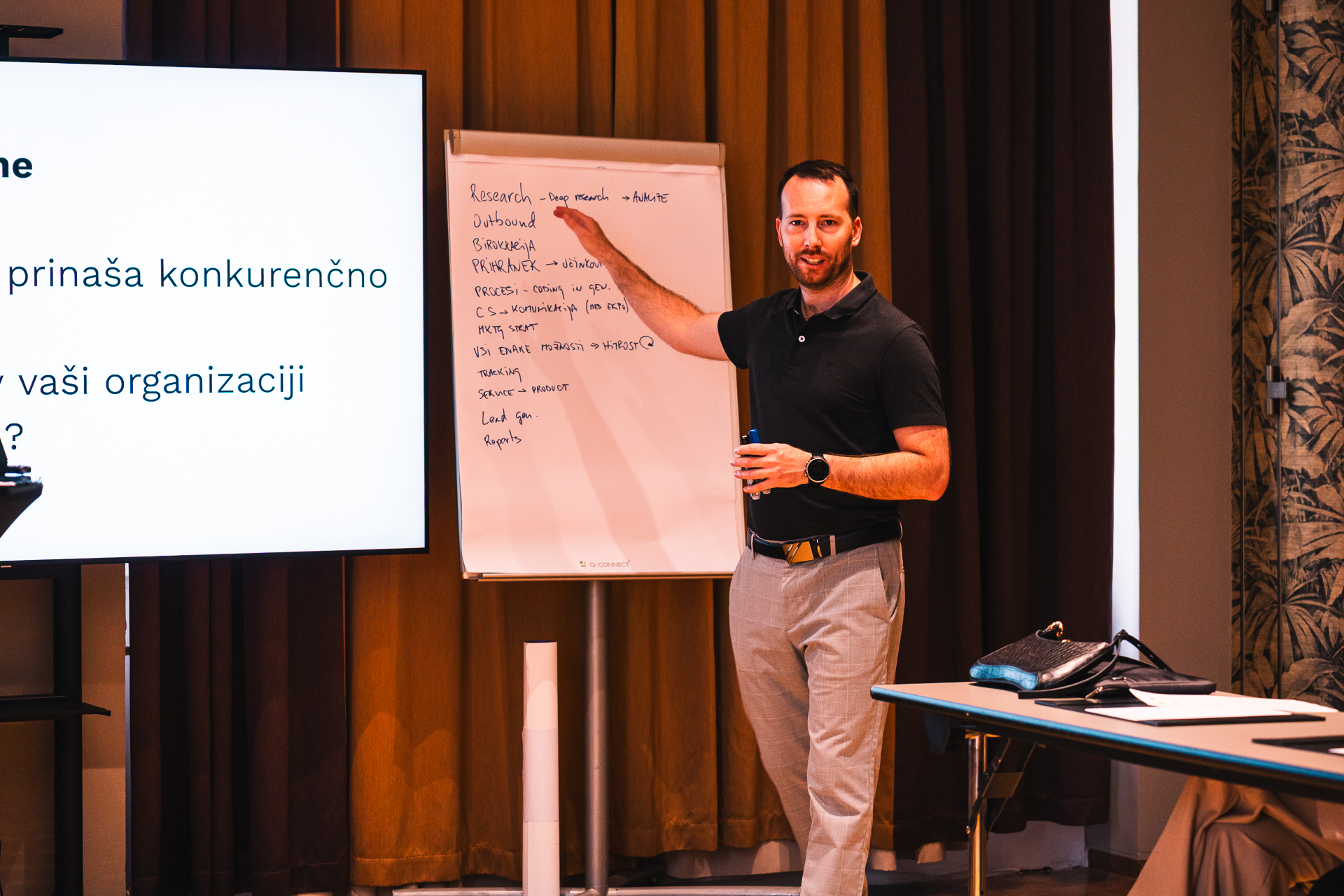
Enej Gradišek, speaker at AI Boost
To help identify where AI can truly deliver the most value, Enej introduced a simple but effective decision-making tool: the Value × Time Method. It’s a way of thinking that helps you pinpoint the tasks that take the most time and create the most value and are therefore ideal for automation with AI.
IF A TASK TAKES A LOT OF TIME BUT HAS LOW VALUE – DROP IT OR DELEGATE IT.
IF IT HAS HIGH VALUE AND TAKES UP MANY HOURS – THIS IS the perfect OPPORTUNITY FOR AI.
Example: If you spend three hours every week preparing a client report and you know that report is crucial to keeping the business, why not automate part of the process?
And if you’re wondering how the best do it, Enej wrapped up with a recommendation: the Deloitte AI Institute offers a collection of top-tier reports and case studies showing how the world’s leading companies are already using AI to grow, optimise, and gain a competitive edge.
AI as a tool for growth, not just efficiency
When someone tells you that 75% of small and medium-sized enterprises are already testing AI solutions and that 91% of them are reporting positive results, the question is no longer “Should I use AI?” but “Where do I start?” At the workshop, Manca Gruden sent a clear message: AI is no longer the future, it’s a tool for the here and now. And the numbers speak for themselves: 60% of companies report significant time and cost savings, especially in marketing. Those who automate wisely are also seeing increased revenue and higher customer satisfaction.
Manca walked us through the key areas where companies are already successfully using artificial intelligence and where automation is most beneficial:
- Customer support and sales automation. Chatbots, AI-generated emails, and virtual assistants speed up response times, improve customer experience, and reduce costs.
- Internal process automation. Accounting, HR, administration, IT helpdesk… Automation here saves time, reduces cost per transaction, and speeds up internal workflows.
- Data, personalization, and marketing automation, including email marketing, social media, and SEO. This impacts revenue growth, customer retention, marketing ROI, and cycle time.
- Production and operations automation, involving robotic process automation (RPA), AI-powered quality control, predictive maintenance, etc. This leads to time savings, lower costs, and higher efficiency.
To demonstrate the power of automation, Manca shared the example of a Swedish bank that used an AI agent to handle two-thirds of all calls, replaced 700 employees, and generated $40 million in additional profit.
This isn’t the future, it’s already happening. The only question is: are you among those who know how to implement it?
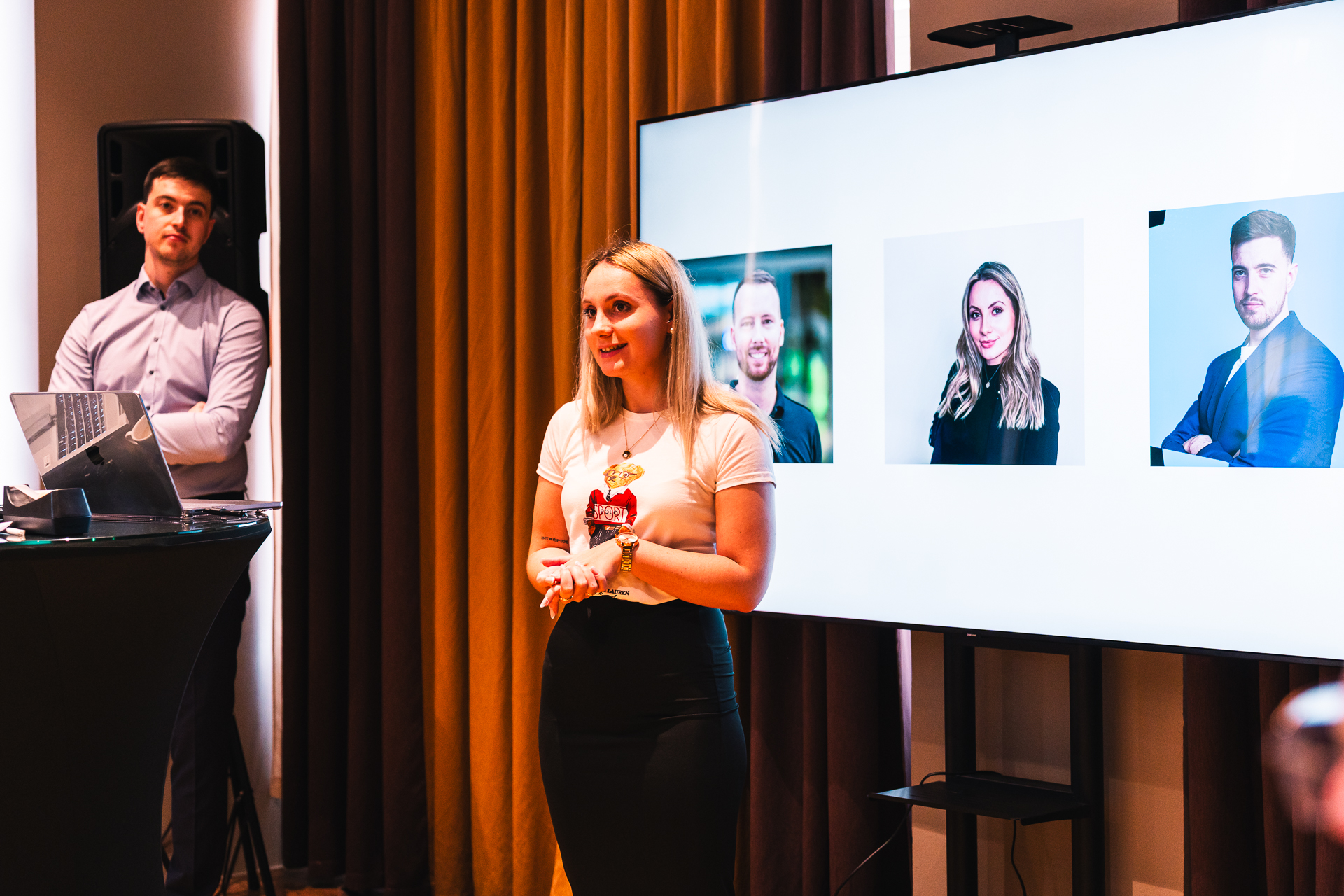
Manca Gruden, speaker at AI Boost
Manca's 6 steps for successfully getting started with AI automation:
-
Identify everyday routines – let AI handle repetitive tasks.
-
Ensure clean data – it's the fuel for all automation.
Start small, but start now. - Involve and train your employees.
- Use simple, scalable tools.
- Monitor, adapt, and improve constantly. AI isn’t a “set and forget” solution—you build with it.
Od idea to prototype - in one workshop? With AI, yes!
While Manca Gruden laid the strategic groundwork for thoughtfully introducing AI into business, Miha Boršič took it one step further—straight into practice. His approach was clear and resonated strongly with entrepreneurs: less theory, more working solutions right now. Instead of talking about what AI might do someday, Miha demonstrated what already works—even without writing a single line of code.
In just a few hours, using tools like Make, n8n, and Lovable, we learned how to start building our first AI prototypes ourselves. At the same time, we clarified the fundamental difference between classic automation and AI-powered automation. As Miha explained:
“Basic automation does what you tell it to.
AI does more. It understands you, your company, and your customers and it knows how to find the best way to complete a task faster, smarter, and more tailored.”
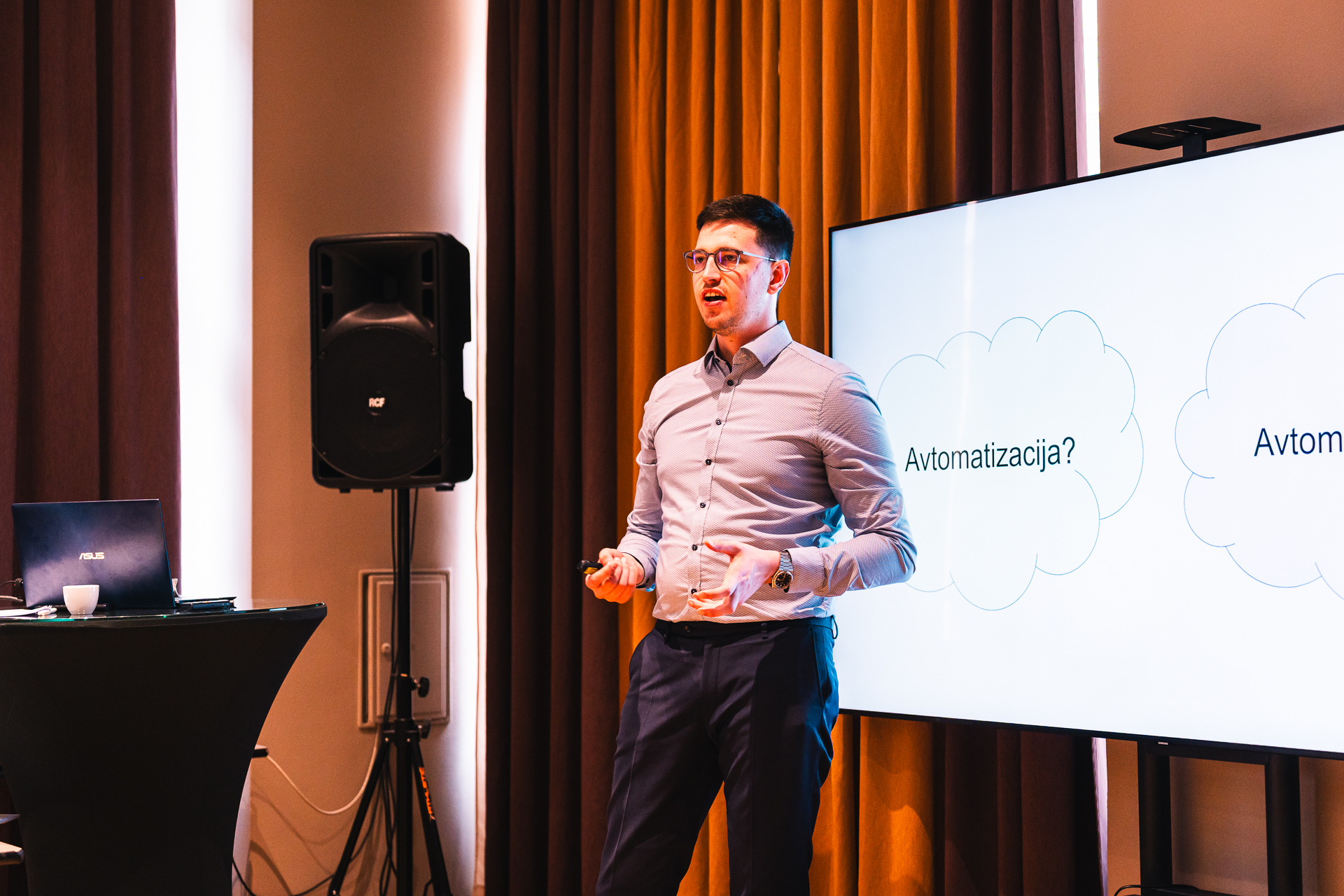
Miha Boršič, speaker at AI Boost
With this understanding, he encouraged us to think like an Augmented CEO—a leader who manages not just people, but also data, technology, and automation. Such a leader asks three key questions:
- Can this process be automated?
- Do I need AI to do it?
- What's the cost versus the outcome? (i.e. price/performance)
And if we get it wrong sometimes? That’s part of the process. Successful leaders test, improve, and know how to seek good advice.
Tools to get you started, fast
Miha introduced three key tools that allow entrepreneurs with zero coding experience to launch their first automation:
-
Make: A user-friendly platform for connecting apps like Gmail, Sheets, Slack, and CRM systems into automated workflows. With 2,000 free monthly operations, it offers a solid starting point at zero cost.
-
n8n: An open-source alternative to Make, with no usage limits and minimal operational costs—an ideal pick for budget-conscious businesses.
- Lovable: A no-code/low-code platform that allows you to create working apps or websites using just a few natural language prompts. Fun fact? The AI BOOST website was built with Lovable in under two hours.
Want to launch a simple landing page in 15 minutes? Lovable makes it possible. While it's not a complete solution, it's a powerful step toward quick idea testing. Other tools like Cursor, Windsurf, and Stitch also support fast prototyping and learning—great for experimentation.
Miha also highlighted another useful tool: Google NotebookLM—ideal for note-taking, summarizing, and even assembling podcast scripts.
Agents of the future
One of the most exciting parts of Miha’s talk was about AI agents based on large language models (LLMs). These agents can be integrated into internal systems like CRMs or email platforms and perform actions using built-in tools or “skills.” He highlighted voice-based agents, already well-developed in some countries, which can: analyze conversations with clients, determine what happened during the call, gauge the level of interest, log whether a lead is worth pursuing.
We also watched a live demo using ElevenLabs, where the AI recognized the speaker’s voice, followed the conversation, and then independently tagged the lead, evaluated interest, and estimated the sales potential.
These aren’t just bots, they’re becoming digital coworkers: LLMs that understand context, use tools, and save time by evaluating leads automatically.
From personal story to AI solution: Klemen Selaković
For Klemen Selaković, co-founder of Astra AI, the journey into artificial intelligence began with a personal memory—often wishing, as a child, for more learning support than he had access to. Years later, when he discovered the power of modern AI, an idea struck him:
What if AI could become a personal math tutor—always available, affordable, and tailored to each learner?
Together with co-founder Andrej P. Škraba, they turned that idea into reality, creating a tool that offers others what Klemen himself didn’t have growing up.
“We saw that this could be a true alternative to a human tutor—always accessible, affordable, and personalized,” Klemen shared. And so, Astra AI was born.
Today, Astra AI is growing into a tool for personalized learning, adapting constantly to each student's knowledge, pace, and needs.
“This is something a textbook can’t do, a teacher in front of a class struggles with, and a human tutor rarely achieves. But AI can simulate that one-on-one interaction—and do it for many,” he added.
.jpg)
Klemen Selaković, guest speaker at AI Boost and co-founder of ASTRA AI, Photo: Marko Ocepek
Still, Klemen emphasizes that AI can’t replace the human side of education:
“A teacher is more than just a knowledge transmitter. They’re a mentor, a source of inspiration, someone who knows how to motivate. That has to stay the way it is. AI should complement, not replace, the human connection.”
He describes his own relationship with AI with healthy realism: “To me, AI is like a junior assistant. Aa director’s extension you need to give clear instructions to. It’s not superintelligent (yet), but if you guide it well, it can save you a lot of time.”
For entrepreneurs still hesitant about AI, he offers this advice:
“Don’t look at it too technically, look at it historically. Every revolution had its skeptics—steam engines, electricity, the internet. Those who hesitated fell behind. If AI scares you, read some history.”
What drives Klemen most is the unpredictability of creation—the hope that, day by day, he and his team are building something to be proud of. He wrapped up the AI BOOST workshop with a thought that captured the spirit of the event:
“What inspired me most was the youthful energy. That gives me hope—young people aren’t waiting, they’re ready to create.”
AI is not the future, it's the present we're co-creating
The AI BOOST workshops made one thing very clear: artificial intelligence is no longer reserved for tech giants or IT experts. Today, it's accessible and intuitive enough for any entrepreneur to start using—no matter the size of their team, their technical skills, or their business focus.
Participants like David Škrbec from Astra AI and Mark Pihlar from GaiaCell agreed that AI doesn't just help companies optimize—it opens doors to entirely new products, markets, and ways of thinking. David shared: “What mattered most to me was getting hands-on with the tools. That part made me really think about how to use them in my own business.”
And what impressed Mark?
“It’s not something to be afraid of—it’s something we need to embrace. AI can help us build better products.”
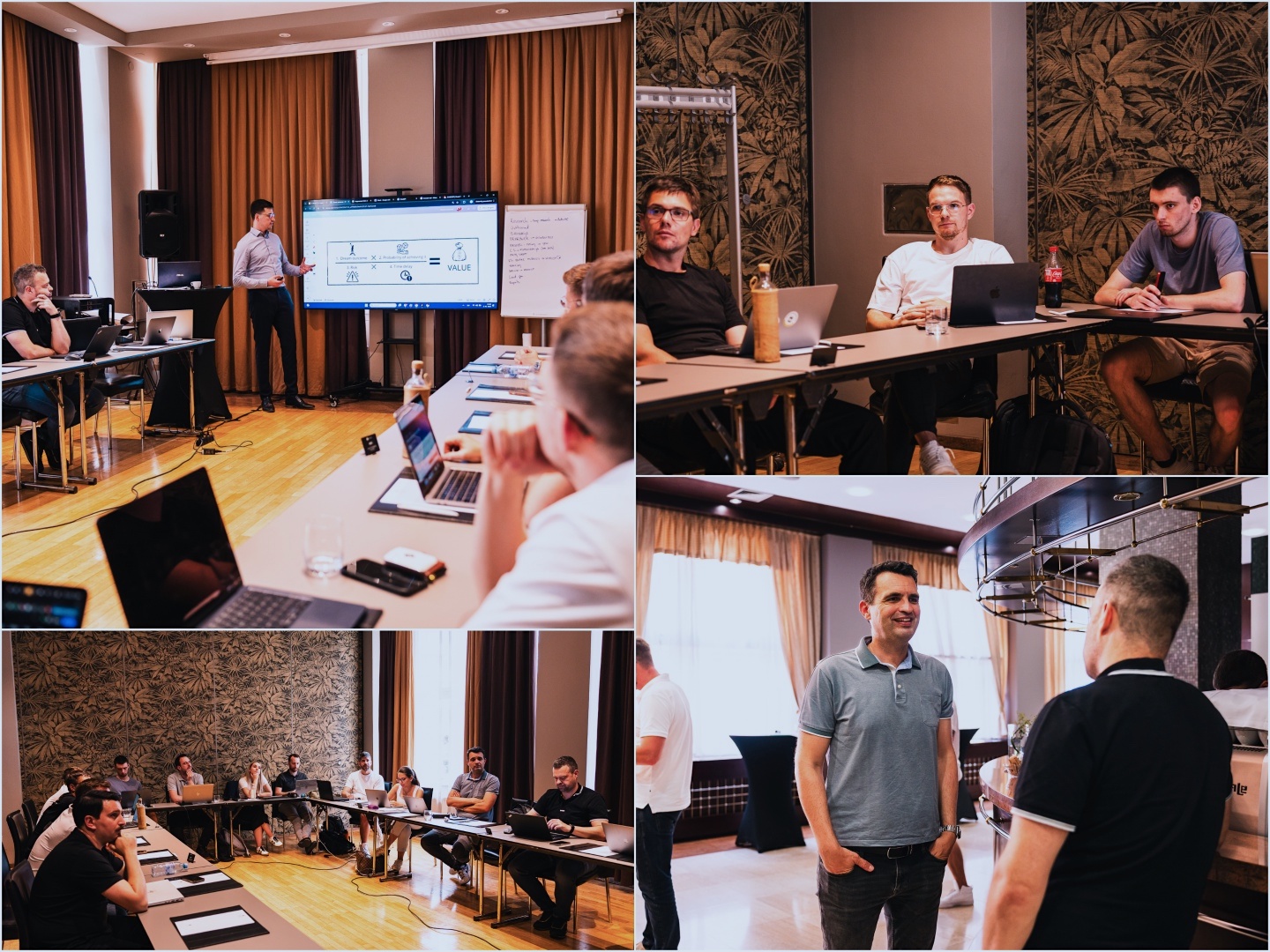
Participants at AI Boost
Throughout the entire program, one feeling kept surfacing: Something important is happening.There was a shared sense that the knowledge gained today could already change the way we work and create tomorrow.
AI BOOST didn’t just offer answers—it gave participants the push to take the first step, to test, learn, and grow with confidence.
What is AI BOOST?
AI BOOST is a series of free, hands-on workshops organized in June 2025 by Združenje YES in collaboration with the Slovene Enterprise Fund.
Over the course of a 40-hour program, participants gain practical knowledge, tools, and real skills for immediately applying AI in their business. The workshops focus on process optimization, prototyping, and the safe, compliant use of AI—helping entrepreneurs take concrete steps toward automation.
The emphasis is on practice, interaction, and instant usability. By the end of the program, each participant walks away with functioning solutions and a clear action plan for implementation.
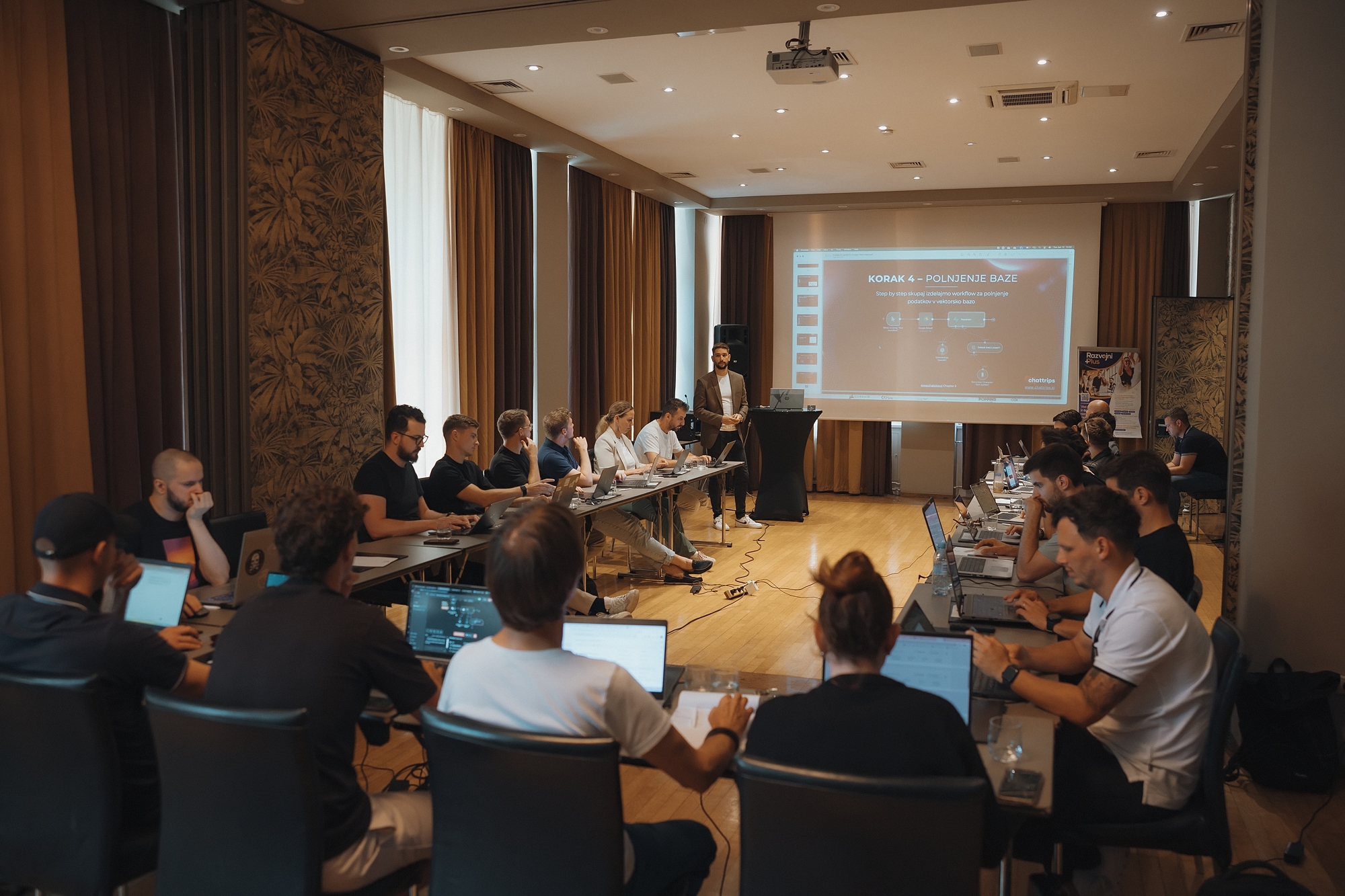

Photo: Marko Ocepek
The AI BOOST workshops are a key component of the Razvojni Plus program, designed to provide highly specialized support for innovative startups and SMEs aiming for faster, global, and sustainable growth. Razvojni Plus offers: expert mentoring, targeted trainings, study visits, matchmaking, networking and promotional events. Its goal? To help companies build key competencies, enhance competitiveness, and connect efficiently with investors, partners, and international markets.The program is aimed at: recipients of the P2 incentive, companies with active SK or SI-SK contracts, businesses listed in the Register of Innovative Startups, other innovative SMEs, including fast-growing scale-ups. Razvojni Plus is managed by the Slovene Enterprise Fund in collaboration with top public and private players from the startup ecosystem.It is co-financed by the Republic of Slovenia and the European Union through the European Regional Development Fund.
###
The program is co-financed by the Republic of Slovenia and the European Union, specifically from the European Regional Development Fund. It is implemented based on the program ‘Substantive support for faster global and sustainable growth of innovative SMEs (DevelopmentPlus Program)’ within the framework of the Slovenia’s EU Cohesion Policy Programme 2021-2027.
.png)









